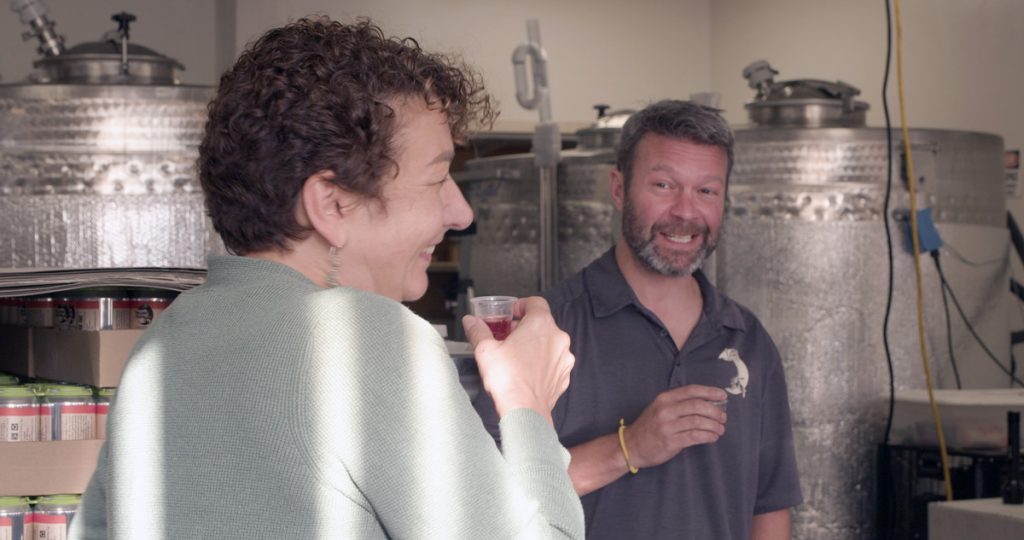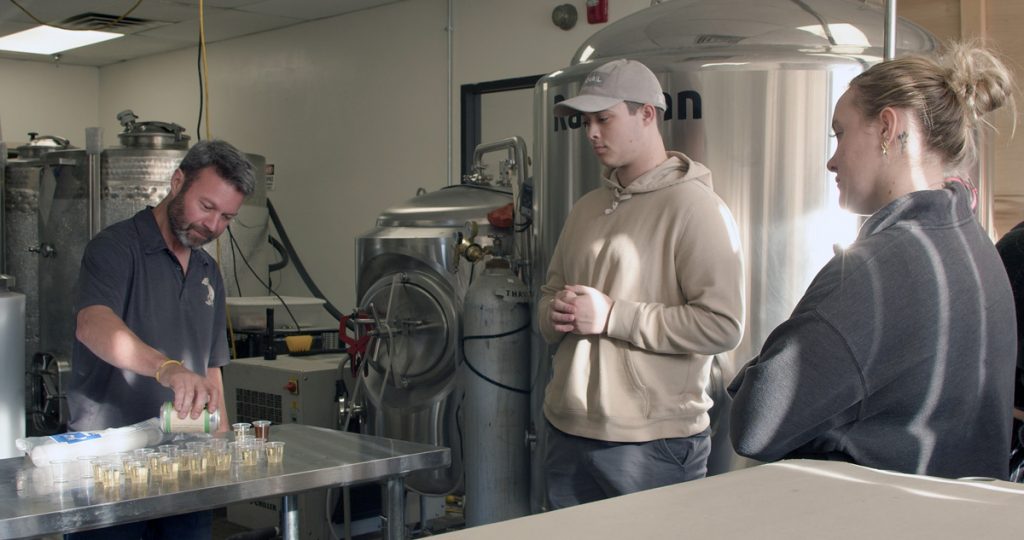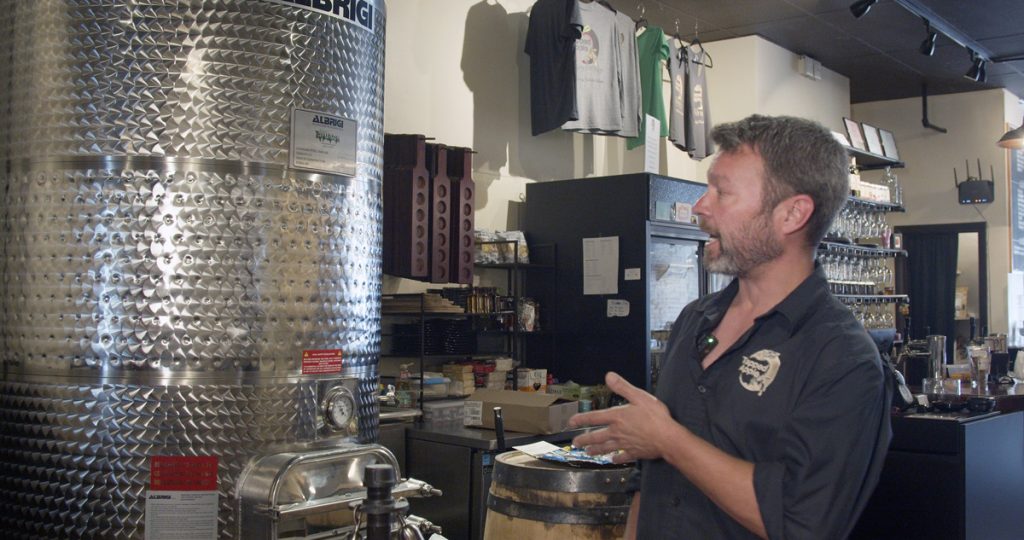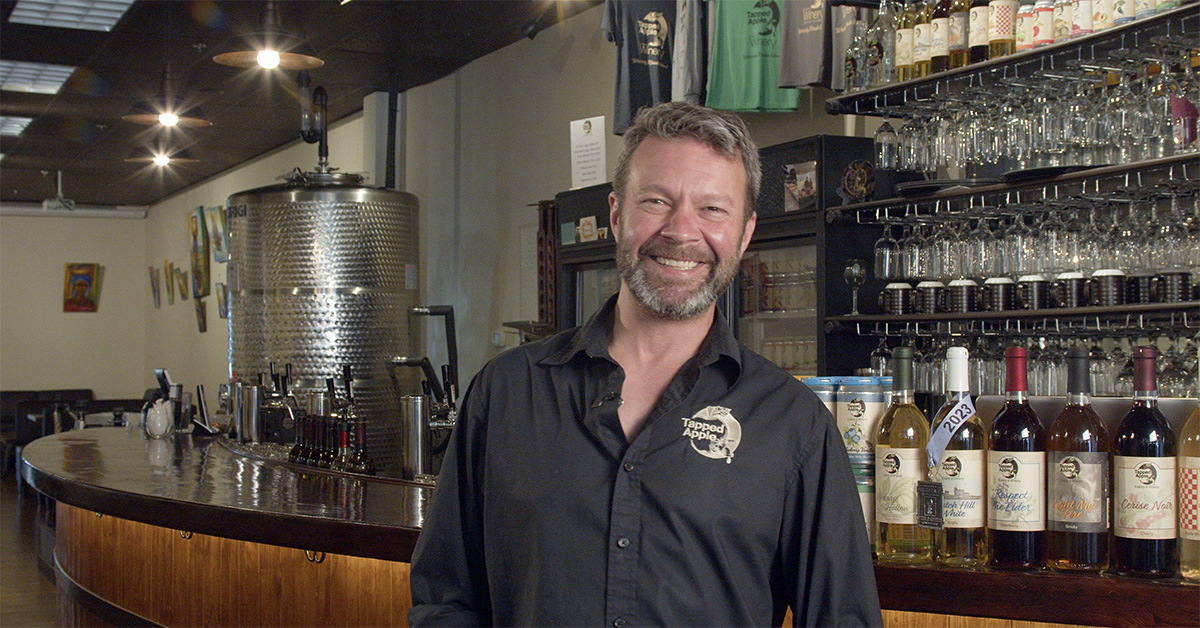An Interview with Jay Wiedenheft at
Tapped Apple Cidery & Winery in
Westerly, Rhode Island
A family venture, Tapped Apple Cidery & Winery in Westerly, Rhode Island is the shared entrepreneurial passion of three generations of Wiedenhefts: John III, John IV (“Jay”) and John V (“5”). Tapped Apple is Rhode Island’s largest cider maker; there is one place in Newport and one in Warren that make cider. In preparation for launching JWUpro’s new online, self-paced course, Craft Cider Making for Beginners, we asked Jay to tell us about Tapped Apple’s evolution and to provide tips for people interested in making their own apple cider and wine or starting an entrepreneurial cider venture.
Marketability of Apple Cider Beverages
As microbrewing and craft beer has become popular in the 21st century, interest in craft cider making has been growing. The cider market includes sparkling cider, still cider and apple wine. “Cider Market Size was valued at USD 2.48 Billion in 2023. The cider industry is projected to grow from USD 2.93 Billion in 2024 to USD 9.52 Billion by 2032.”
Today, increased cider crafting and consumption is driven by the popularity of lower-alcoholic beverages, desire to support businesses that craft beverages from local resources — and enjoyment of the unique flavors derived from blending fruits with apple cider and wine.
The History And Evolution of Tapped Apple
Twenty years ago, John III was making delicious wine as hobby. Jay (John IV) bought a house across the street from his dad and began to make wine with him. Jay explains, “We went from making test batches in the basement, using 5-gallon carboys, to making up to 200 gallons per year, which is the max you can produce for family use.
“Making wine from grapes shipped from California was expensive — it didn’t make sense. We looked for a locally grown alternative and it turned out to be apples. We would bring the wine to parties, and people wanted to buy it, but that’s not legal. So, we started giving it away.
“One day, as my son (John V) was getting ready to graduate from high school, we were sitting on the patio and my dad said, ‘You know, maybe we should open a winery.’ I responded, ‘All right, I’m not really happy at my job. So, let’s do it and see what happens.’ It was time for something new.”

Learning The Craft
At 18, Jay worked in a restaurant, then provided customer service for 16 years as a table games dealer at a casino. Admitting he is not a ‘book learner,’ Jay gained experience primarily by experimenting with his dad.
Asked when he knew that cider making was his calling, Jay responded, “I didn’t. I’m very much a hands-on person. I like solving problems and learning how to make cider was an interesting problem to solve. When I cook, I enjoy the various flavors of food. Making cider is similar — we come up with all different flavor tests and figure out what’s going to work.”
“Cider making offers me a constant flow of new and interesting problems to solve — like figuring out how to move from canning to bottling. Or figuring out how to thoroughly clean the special kegs we fill for cider that goes to the bars. Once we solved that problem, we had to build the cleaning equipment – and keep it low budget.
“During COVID-19, we bought a tiny little canner that didn’t come with a manual. I had to figure out how it worked. It was challenging, but also good, because I’m never bored! We quickly outgrew that tiny canner and bought a much larger, much more automated canner, which we are using today.”
Role And Challenges Of Being In The Cider Industry
Speaking about his personal challenges in managing a cidery, Jay comments, “For me, this business is like herding cats. Anytime you have a family business, trying to get everybody on the same page — with their different opinions — it is not the easiest job.
“My role in in the cider industry is that it’s my job is to make sure this business thrives, so I have something to pass to my son, John V. I just got a promotion to CEO of our business, which doesn’t mean more money — just more work.
“Although I’m very focused on what my own business is doing, I’m not as sure about what the challenges are in the whole cider industry. I do share the concerns of others in this industry about climate change and the economy. However, I was able to pivot during the pandemic, when we went from just being a tasting room. I bought a little canner, and we started canning the cider. I brought our distribution up to 25 locations and then handed that off.
“Now we’re covering all of Rhode Island and starting to go into Connecticut. I just take each opportunity and look at it in different ways, so I can figure out what I need to do — not just to survive but to thrive.”

The Public’s Perceptions About Cider In The Beverage Industry
“When we talk about cider, including apple wine, people tend to think that any fruit other than grapes is comparatively lowbrow. They don’t have the experience with Spanish ciders or some of these older cider varieties have been around for a really long time.
“Their experience has typically been with super sweet blends produced by major players in the industry. Those brands do a great job and are financially profitable, but we want to offer different tastes for different palates.
“Our ciders range from bone dry to very sweet, so we have a little bit of something for everybody. Our dry wine is like a Pinot Grigio. We’re coming out with a blueberry wine that is comparable to a red table wine made from grapes. We hope our unique blends and fusions of flavors will change people’s preconceptions and give apple ciders and wines a fair chance.”
Jay describes another challenge in the industry, “I see a lot of places doing lower ABV (alcohol by volume). I appreciate that lower ABV cider is popular, but getting a lower ABV requires watering down the juice. Tapped Apple ciders are 8% ABV, which means that we never have to water down the flavor of our ciders. I see my role in the industry as trying to make the highest quality product on the market.”
Favorite Apples For Cider Making
“We run a blend of apples all year round and only do two single varietals – our Gravenstein, which is an early season high acid, crisp, sweet-tart heirloom variety and the Pink Lady, which is a late season, modern, high acid cultivar. So, I guess I like the high acid apples best! But you need the sweet stuff for the sugar content, you need the acid, you need the tannins, to get the flavor profile that we are known for. We blend the apples as needed to achieve that signature taste.
“We do use crabapple in one of our products. Recently I gave the orchard we buy apples from a list of a dozen varieties and paid for more trees to be planted. We want to improve our products over the years, and it takes years to grow the trees.
“You can use almost any apple to make cider — use everything you’ve got. One of my good friends has been making cider and I’ve been helping teach him for the last couple of years. He and a buddy pick only wild apples up in Vermont. He did 160 gallons this year and his cider is very good. It’s different from ours. We are all making different things and that keeps it interesting.”

Important Things To Do When Making Your Own Cider
Jay emphasizes that when making cider it is crucial to keep everything clean and sanitized. “People don’t take it seriously enough or they use a caustic cleaner that is not a sanitizer. Or they use soap when you’re supposed to use an actual sanitizing product. Some people use a bleach product. Others use an iodine base. We use Saniclean, a low foam solution and final acid rinse that effectively sanitizes and removes flavors and odors.”
Jay adds, “We also mix up a Sulfite SO2 solution that we call ‘Instant Kill.’ Anytime anything touches something it shouldn’t, we spray everything down to kill potentially harmful microorganisms. By using it together with proper cleaning and sanitizing, we don’t have to worry about contaminating the cider with bacteria that would introduce “off” flavors and odors.”
“Aside from that, when you’re filling tanks and you’re not in active fermentation, you want to fill them all the way up. I can’t tell you how many times I’ve seen somebody with a container that is a quarter empty, which is too much headspace — too much air. Oxygen in the process at the wrong time can cause the cider to oxidize and change flavor or become contaminated with mold and bacteria.
“It’s up to you whether you add sulfites at the end. My brother doesn’t add any sulfites — I do. We add a little bit at the very end of the fermentation, and the sulfite dissipates over time as we age our cider. Our final product is very low in sulfites, but it ensures a quality product. We don’t add sulfites at any other time. If you’re against doing sulfites, you can still have a good product. What is most important is to clean your equipment and top up your tanks.”
Future Plans For Tapped Apple
“Our operations include the taproom and our other space, which is for aging and has more fermentations, and also the canning machine that is located across town. Right now, all of that happens in Rhode Island. The distribution is about to cross the border into Connecticut. I’m currently in conversations with a distributor in Connecticut to take over the eastern side.
“Short-term, I want to max out my sales with the amount of space that I have going on in Rhode Island right now – and then I’m going to buy a piece of property in Connecticut and move there.
“I love this location and the vibe here is really nice. The people that come in are very nice, too, but I need some outdoor seating. And I’d rather pay for my own property than pay for somebody else’s. We want to invest in ourselves.”
Love What You Do
“I’ve met a number of young people who’ve come to visit us from Johnson & Wales — there’s probably three or four over the last couple of year that stand out in my mind. They were very excited and interested in cider making. Other people do come in and talk with me about making their own cider.”
Jay advises, “If you want to make cider — or for anything you choose to do — you need to feel excited. You have to find something that interests you, so that when you get up in the morning, you can’t wait to go and do it. If you’re bored or if you’re only halfway there, go punch a clock. I’m ‘on’ every day — still answering my phone even when I’m on vacation — but because I love what I do, that is a good thing.

Learn To Make Cider For Home Use Or Start Your Entrepreneurial Career
Interested in learning how to produce unique hand-crafted ciders and cider wines? JWUpro’s self-paced, online course, Craft Cider Making for Beginners — including tips from cider industry experts in Rhode Island — is open for enrollment!
Why not take the next step with us and explore what JWUpro has to offer? Whether you’re looking to join as an individual or an organization, JWUpro is here to support you.
Visit the JWUpro website or browse our online training catalog today. If you’re looking for more information, simply fill out our inquiry form for individuals or inquiry form for organizations today and we’ll be in touch.
Photos: JWU Multimedia Production Team
